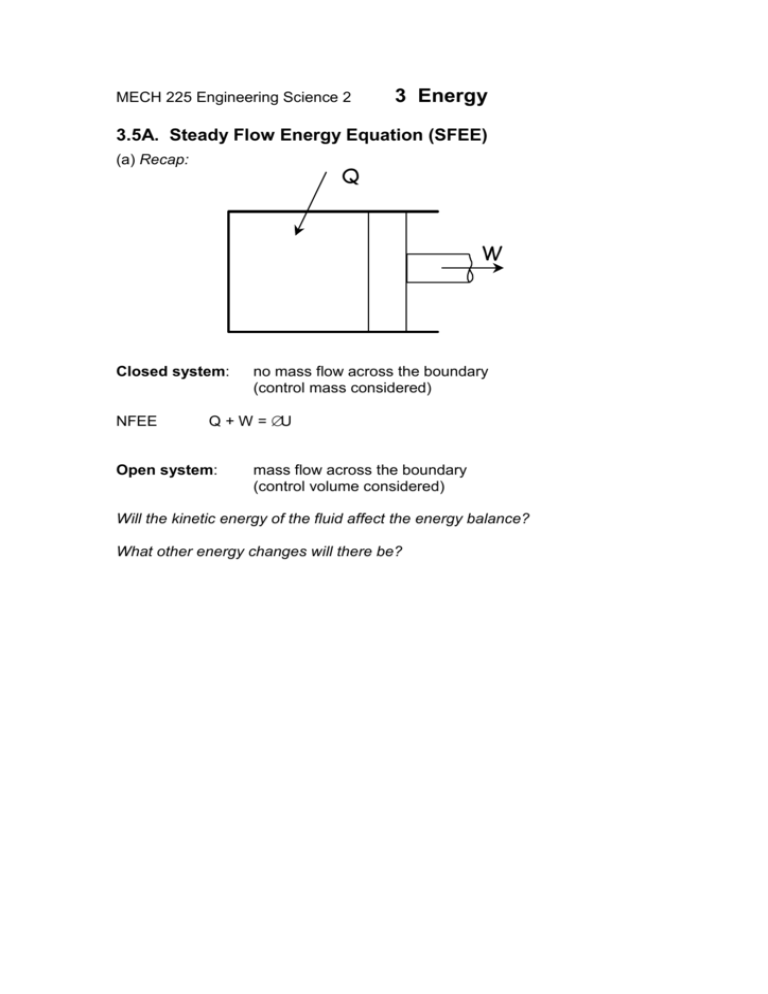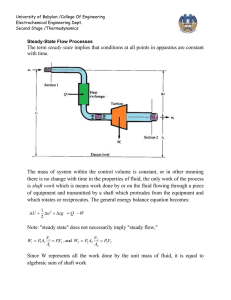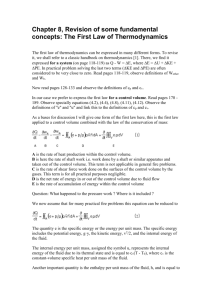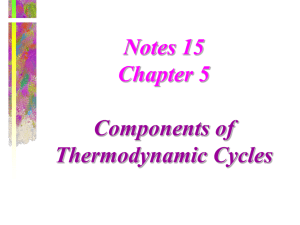3.5A Steady Flow Energy
advertisement

MECH 225 Engineering Science 2 3 Energy 3.5A. Steady Flow Energy Equation (SFEE) (a) Recap: Q W Closed system: NFEE no mass flow across the boundary (control mass considered) Q + W = ∆U Open system: mass flow across the boundary (control volume considered) Will the kinetic energy of the fluid affect the energy balance? What other energy changes will there be? 2 2’ Q 1 1’ W (b) The First Law of Thermodynamics: Q + W = ∆E Q, W are energy transfers by heating and working, respectively Q = heating W consists of two parts: (i) shaft work, work which is transferred to the surroundings (ii) flow work, the work required to push the fluid through the control volume, where the control volume is shown above between 1 and 2. ∆E is the change in the total energy, which will be made up of changes in: (i) internal energy (due to changes in temperature) (ii) kinetic energy (due to changes in flow velocity) (iii) gravitational potential energy (due to changes in height of the fluid) (c) Energy transfers – the flow work term 1 1’ P ∆m L A Work done in getting the mass ∆m of fluid into the system, from 1 to 1’: = force * distance Flow work = (pA)*L Flow work per unit mass = pAL pAL pAL = = ∆m ρ( ∆V ) ρAL p = pv ρ where ρ is the density of the fluid ,and v is its specific volume (volume of 1 kg). ∴ flow work per unit mass = At the inlet, flow work = p1v1 (work done on the system to get fluid in). At outlet, flow work = -p2V2 (work done by the system, as fluid exits). The shaft work is denoted by W s. (d) Changes in total energy of the control mass, ∆m As the mass ∆m moves into the control volume, at flow station 1, for steady flow, an equal mass ∆m will move out of the control volume, at flow station 2. There will in general be changes in its: 1 (i) kinetic energy: ∆Ek = ( ∆m)(c 22 − c 12 ) 2 where c is the flow velocity (a change in symbol, so as not to confuse it with “v” for specific volume or “u” for specific internal energy) (ii) gravitational potential energy: ∆Ep = (∆m)g(z2 – z1) (iii) Internal energy: ∆U = (∆m)(u2 – u1) Therefore, when we apply the First Law of Thermodynamics to the fluid in the control volume, we get: 1 Q + Ws + p1V1 – p2V2 = ( ∆m)(c 22 − c 12 ) + (∆m)g(z2 – z1) + (∆m)(u2 – u1) 2 Note that because the flow is steady, the properties of the fluid within the volume between 1’ and 2 do not change. All that has changed are the properties of the small mass ∆m entering and leaving the control volume. For unit mass of fluid entering the control volume, divide by ∆m: 1 q + ws + p1v1 – p2v2 = (c 22 − c 12 ) + g(z2 – z1) + (u2 – u1) 2 which can be written as: 1 q + ws = (c 22 − c 12 ) + g(z2 – z1) + (u2 – u1) + p2v2 - p1v1 2 We introduce a new term (see also 1.6), enthalpy Because the combination of energy terms (u + pv) occurs so frequently in thermodynamic analyses, it has been given a special name and symbol, enthalpy, h. Thus h = u + pv is the specific enthalpy While H = U + pV is the enthalpy of a mass, m, say. So we can rewrite the energy balance above as: q + ws–= 1 2 (c 2 − c 12 ) + g(z2 – z1) + (h2 – h1) 2 This is the steady flow energy equation (SFEE) What are the units of each term? , the SFEE becomes: For a mass flow rate, m +W =m éh 2 − h1 + 1 (c 2 − c 2 ) + g( z 2 − z1 )ù Q s ê ú 1 2 2 ë û Where is the rate of heating applied to the control volume Q is the rate of shaft work input W s Since these are rates of energy transfer, the units are watts (Js-1) NOTE: Key assumptions are: steady flow properties constant with time. Further reading: Bacon and Stephens, Mechanical Technology 23.9 Rogers, G and Mayhew, Y, Engineering Thermodynamics Work and Heat Transfer The Open University, T236 Introduction to thermofluid mechanics Ch 4 Block 6











